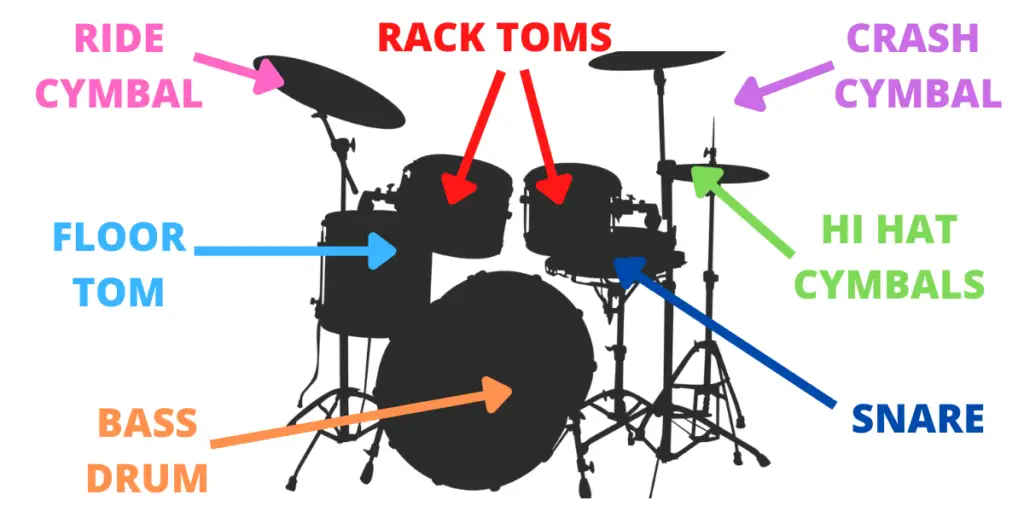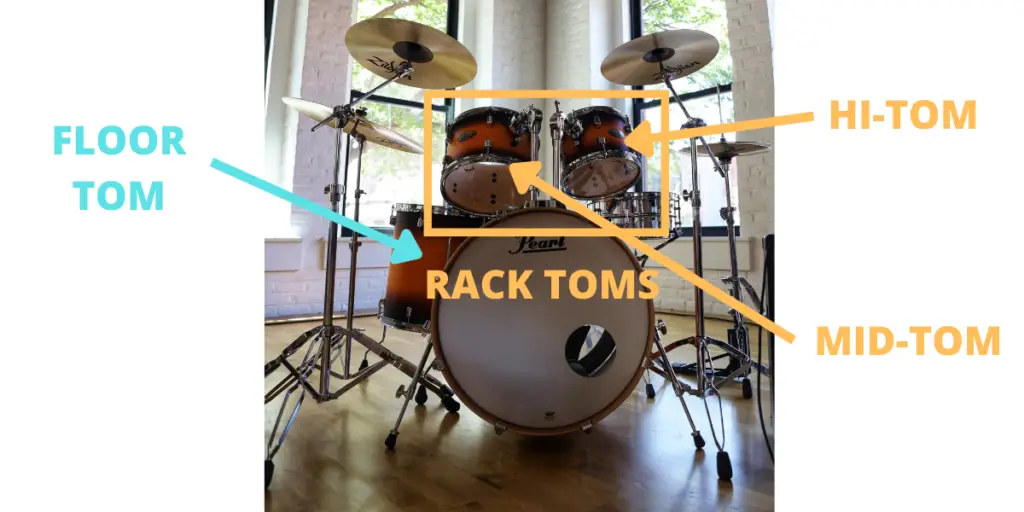Tom toms can be used in a range of ways but the most common use is during a drum fill. There are two main types of tom on a drum kit: the floor tom and the rack toms. In this article I’ll explain the difference between the types of toms in detail.
Floor vs Rack Toms 101
Floor toms have a wider diameter and are deeper compared to rack toms. Floor toms have a lower pitch and more sustain and resonance compared to rack toms. Rack toms are usually mounted on the bass drum whereas floor toms are usually positioned under the ride cymbal.
Rack toms are also known as mounted or hanging toms. Most drum kits will have two rack toms which are referred to as the hi-tom and mid-tom.
The hi-tom is typically slightly smaller than the mid-tom and hence the mid-tom produces a deeper sound. The hi-tom is typically on the left nearest to the hi-hat/ crash cymbals.
The floor tom is also referred to as the low tom and sits on the right of a right-handed drummer, underneath the ride cymbal. They have the lowest pitch of all the different types of tom.

| Rack Toms | Floor Toms |
| Located above the bass drum | Located below the ride cymbal |
| Usually 2 per drum kit | Usually 1 per drum kit |
| Diameter between 8″ and 12″ | Diameter between 14″ and 16″ |
| Depth between 6″ and 10″ | Depth between 10″ and 14″ |
| Higher pitch | Lower pitch |
| Short, sharp sound | Deep, resonant sound |
How Many Toms?
Most drum kits have 3 toms. Usually, two of the toms will be rack toms and the third tom will be a floor tom.
However, some drummers prefer have two floor toms and a single rack tom, or two of each. Equally, some players prefer a kit with only 2 toms: one floor and one rack. This is a popular configuration amongst jazz drummers.
Since toms are mainly used for drum fills, the amount a player chooses to have in their kit is a personal preference. It really depends how much the player likes to use their toms and which positioning they prefer.
Check out my article comparing different numbers of toms in a kit for more information.
Mounting Position
Floor toms are usually placed on the ground underneath the ride cymbal. Most floor toms have legs to keep them off the ground so that they sound as resonant as possible. Alternatively, the floor tom may be mounted in a similar position.
Rack toms can either be mounted on the bass drum or on a stand that sits behind the bass drum.
When there are two rack toms in the kit, the smaller one (also known as the hi-tom) will typically be located on the side closest to the crash/ hi-hat cymbal, and the larger one (mid-tom) will be on the side closest to the ride cymbal and floor tom.

Size
Floor toms are larger than rack toms both in terms of the diameter and depth.
The most common floor tom sizes are 14″ and 16″ which refers to the diameter. The depth of a floor tom ranges between 11″ and 14″ on average. Deeper floor toms have more sustain. The larger the head is, the lower the pitch.
The most popular rack tom sizes are 8″, 10″ and 12″ making them smaller compared to floor toms. The depth of a rack tom can vary but is typically between 6″ and 10″.
Check out my toms size guide to learn more about the differences between small and large toms.
Sound
Since floor toms have a larger diameter and are deeper compared to rack toms, they have more sustain and a lower pitch.
Rack toms sound thinner and sharper compared to floor toms which sound deeper due to their lower pitch. Floor toms have more depth which means there is more air inside the drum which gives it more resonance and sustain.
As I mentioned earlier, there are two types of rack toms in most kits: the hi-tom and the mid-tom. The hi-tom has the highest pitch as it is smaller compared to the mid-tom.
Tom-Tom Pitch (highest to lowest): hi-tom (rack) > mid-tom (rack) > floor tom
Check out this video to hear the sound of each type of tom.
Function
Tom-tom drums are mostly used during drum fills and the basic function is the same regardless of which type of tom you are using. Whether you hit the rack tom or floor tom really just depends on the type of sound you want to achieve, or even your positioning to some degree.
Here are some more articles that you might find useful:
